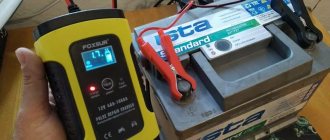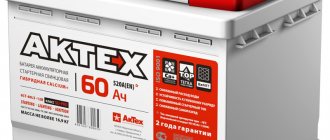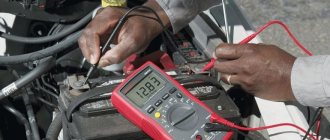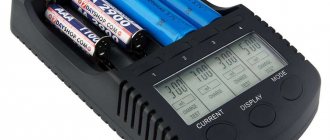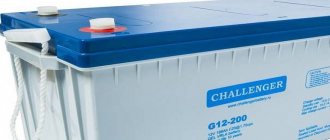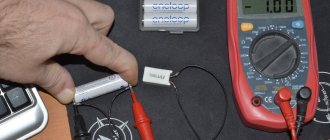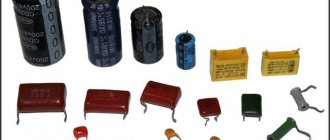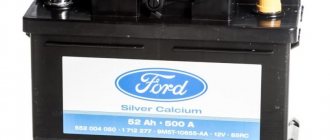Checking the car battery charge
Checking a modern car battery is simplified. After all, they include sensors that help determine the charge level. Such sensors are used by drivers to determine the approximate state of the power source.
A more accurate check of the battery capacity is carried out using a multimeter. This device is equipped with 2-3 operating modes. To check the battery voltage, perform the following steps: Setting the voltmeter mode. Measurements are carried out in the range of 0–20 V.
- Disconnecting electrical wiring of vehicles and conductive terminals from the power source.
- Connecting cables with clamps to the appropriate terminals.
- The set voltage is recorded.
Checking the battery charge with a multimeter is easy. But at the same time, it is very important to follow the procedure established by experienced craftsmen. After all, it depends on how accurate the result will be obtained.
A working battery produces a voltage of 12.5–12.6 V. If lower values are displayed on the monitor, then recharging is performed. After this, the voltage must be measured again.
If the charge of the battery being tested is 11V, then its operation is not allowed. After all, dead car batteries affect the performance of the generator and power units of vehicles.
Before checking the charge of the power source, it is disconnected from the mains. It should be at rest for 4-6 hours.
Symptoms of a dying battery - when to look under the hood
Signs of battery wear on a car usually appear most clearly when the engine starts and when the load on the on-board network increases . Some of them may indicate either the exhaustion of the battery life itself, or simply a drop in the charge level due to a malfunction of the generator or increased energy consumption caused by improper operation of the equipment.
The main symptoms of a dying car battery:
Symptoms of a tired battery using the example of Lada Vesta: video
- the starter has difficulty moving the flywheel, especially at low temperatures, the speed clearly slows down when the key or start button is held for more than 2-3 seconds;
- The brightness of the headlight lamps and interior lighting drops significantly when the engine is turned off, and after the start it increases abruptly;
- the battery goes to zero after 12 hours of parking;
- The idle speed drops when additional consumers are turned on, and when the air conditioner is turned on, the engine sometimes stalls;
- turning on the consumer (dimensions and headlights, audio system, compressor for inflating wheels) while parked with the engine turned off causes a noticeable drop in battery voltage;
- When the engine is off, the windshield wipers, windows and power sunroof move too slowly and with difficulty.
If you notice the symptoms described, you need to look under the hood and inspect the battery . The obvious signs of battery failure and their causes are listed in the next section.
How to check battery capacity?
What is battery capacity? How significant is this parameter?
The capacity of a car battery shows how much energy the unit produces in a certain time period. Knowing the actual battery capacity, it is easy to determine how long the device will operate.
Checking with a tester
Testers are used to check the functionality of the power source and establish the capacity. After all, these devices are distinguished by their extensive functionality. They are used to test various power sources.
Before using the tester, you need to learn how to measure battery capacity.
The tester includes a button with which various parameters are measured: capacity, load, current. Before testing, the required mode is selected.
The value obtained during the measurement process is considered approximate. To establish the exact value, mathematical formulas are used.
Application of a multimeter
Checking the battery capacity with a multimeter is easy. After all, this device is distinguished by its simple design and several operating modes.
To check the battery capacity with a multimeter, several methods are used.
Load testing
A light bulb acts as a load when measuring the battery capacity. If during testing the brightness of the light bulb decreases, it dims, and the test stops. After all, this indicates the inoperability of the power source.
Amperage is taken into account when determining the load required to measure battery capacity. If the rated capacity is 7 A/h, then the load value is 3.5 Volts. With such indicators, you can use a car headlight for testing.
To install the battery capacity, perform the following steps:
- Disconnecting the power source from the generator.
- Supplying the load. Under load, the battery operates for 1–2 minutes.
- Load shedding.
- Connecting to a multimeter device. The battery capacity is measured with a multimeter within 10–20 seconds.
- Recording of readings.
A voltage of 12.4–12.5 Volts indicates that the car battery is functioning normally. If a value of 12 Volts or lower is determined, then there is a need to replace the power source.
Control discharge technique
To check the battery with a multimeter using the test discharge method, the load is first calculated. It should be equal to the strength of the discharge current. This parameter is recorded in the technical documentation that comes with the power source.
How to check the battery capacity if the passport is missing? The data is easy to find on the manufacturer's website.
The multimeter remains connected until the current drops to 50-60%. The value that was obtained is compared with that stated in the technical data sheet. If they differ significantly, it is recommended to replace the power supply.
Checking other parameters of the car power supply
A modern multimeter is multifunctional. With its help, not only the residual capacity of the battery is measured.
Voltage measurement
To calculate the voltage, the car battery is switched to voltmeter mode. If a unit whose load is 20 volts or more is used for testing, then enter the corresponding indicator. After adjustment, a black wire is connected to the negative terminal, and a red wire is connected to the positive terminal. Within 1-2 seconds, the monitor will display the voltage value (at constant current).
The voltage of a working power supply is 12.5-12.7 V. The state of the electrolytic composition in this case is normal. Therefore, the car battery is operated in standard mode.
This measurement method is used for alkaline-acid, lithium-ion and other batteries.
Internal resistance testing
The performance of a car battery largely depends on the value of internal resistance. To measure this indicator, you will need a light bulb (power - 12V) and a multifunctional multimeter.
The following list of actions is performed:
- Connecting to the lamp power source. At the same time, charging the car battery is prohibited.
- After 1–2 seconds, probes are connected to the conductive terminals, with the help of which the voltage is determined.
- Turning off the lamp.
- Repeated voltage measurement.
If the battery is in good condition, then the difference in the obtained values will not exceed 0.04–0.05 V. If the difference is more significant, then a more thorough assessment of the technical condition of the power source is required. After all, internal resistance is higher than normal.
conclusions
The condition of the batteries must be monitored. Special devices capable of measuring internal resistance, such as the Fluke BT500 family of testers, will help you do this quickly and at the same time obtain meaningful information about the remaining battery life.
Leakage current test
If you are aware of how to find out capacitance, you need to familiarize yourself with the features of determining leakage current. After all, the capacity also depends on this parameter.
The permissible self-discharge is specified in the technical data sheet that comes with the battery. Maximum energy losses are observed in acid-base power sources, which have different powers.
An increase in battery capacity leakage occurs due to the fact that there are areas in the circuit with poor-quality insulation. If the situation is not corrected, the car battery will discharge quickly. Sometimes poor insulation causes a short circuit or fire.
To determine current leakage, use a multimeter, which is switched to the appropriate mode. The indicator moves to 10 A.
There are two probes coming off the multimeter. The red probe is connected to the positive conductive terminal, and the black probe is completely disconnected. There should be no readings on the monitor at this moment. If the readings are present, then a leakage current is observed. In this case, the on-board system of the vehicle is checked.
How to restore battery capacity?
To ensure the operability of all vehicle components, it is not enough to know how to determine capacity. Motorists should explore ways to restore charge.
Preparation
Before restoring the charge and capacity of the battery, the power source is inspected. Electrolytic leaks are removed from the body. Conductive terminals are cleaned of dust, dirt and oxides.
The contaminated electrolytic composition is drained. It is also mandatory to wash the tanks and cans that are included in the composition.
Lead plates are checked. If the integrity of the elements is compromised, it is not worth restoring the charge. After all, these actions will not bring any results.
Control training cycle
Carry out to reduce the effect of sulfation and restore charge. What is the essence of this cycle? So, the battery is charged and discharged 2–4 times.
To control the process use:
- Hydrometer. With its help, the density of the electrolytic composition is controlled.
- Bulb. With its help they create a certain load.
- Voltmeter or multimeter. Such devices are used to estimate current, voltage, and other parameters.
The frequency and duration of charging is set individually.
Multiple charging
Between charging and discharging cycles, breaks of 12–16 hours are established. The charging time is 7–8 hours. A more precise period is set taking into account the current strength, rated capacity, and other parameters.
A break between cycles is necessary to ensure that there is a uniform potential on the surface of the lead plates.
The number of restoration processes reaches 4–5. During this period, the degree of density of the electrolytic composition increases. If the density has increased excessively, the electrolytic composition is diluted. For this purpose, distilled water is used.
Chemicals
The essence of this technique is to pour sodium solution into the power source. This is done after draining the distilled water and washing the housing. The special solution is poured 2-3 times.
Monitoring the capacity of a car battery helps extend its service life. After all, even minor deviations provoke a rapid discharge, destruction of lead plates, and the formation of oxides. Every motorist can easily choose a way to check this indicator that is ideal.
Signs and causes of a dying car battery
A battery that has exhausted its resource may fail at any time. In addition to the fact that the car may not start when it gets cold or after several short trips, the battery case may be destroyed with electrolyte leaking, failures in the on-board electronics due to voltage surges, etc. In addition, the load on the generator increases . Having noticed signs of a dying battery, you need to take measures to eliminate the causes of their appearance, and then charge the battery or replace it.
Signs of a dying car battery and their causes:
| Battery problem | Why is this happening | What to do |
| Battery drains quickly |
|
|
| Gray light coating on the plates | Deep charge or non-optimal battery charging mode. | Carry out charging with desulfation of the battery or replace the battery. |
| The body is swollen (without damage) |
|
|
| Cracks and leaks on the battery case |
| Replace the battery. |
| Low voltage and electrolyte density after charging | Sulfur from the electrolyte turns into lead sulfate and settles on the plates, but cannot dissolve back due to excessive crystal formation, so the density of the electrolyte decreases. It is also possible that the electrolyte may boil away. | Charge the battery and adjust the electrolyte density. If it doesn’t help, change the battery. |
| Electrolyte is dark or has sediment | Destruction of the active mass of the plates or the formation of insoluble sulfate. | The battery requires replacement as it cannot be restored. |
| Plaque on battery terminals | Electrolyte boils off during charging due to sulfation of the battery. | Add distilled water, charge with desulfation, if that doesn’t help, change the battery. |
The service life of the battery depends on its type:
- ordinary lead antimony and low antimony - about 3–4 years;
- hybrid and calcium - about 4–5 years;
- AGM – 5 years;
- gel (GEL) – 5–10 years.
Signs of deterioration of the car battery may appear earlier with short miles, frequent starts, a large number of additional equipment, for example, an aftermarket multimedia system with amplifiers and speakers of higher power, or malfunctions that lead to insufficient charging or over-discharging. At the same time, in good conditions and with timely maintenance, the battery can last 1.5–2 times longer than expected.
